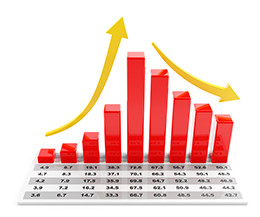 I shared this post earlier this year, and as we look ahead to a 2016 that could bring ongoing volatility, I think it’s a good reminder.
I shared this post earlier this year, and as we look ahead to a 2016 that could bring ongoing volatility, I think it’s a good reminder.
When we consider market returns, we often focus on average returns, assuming the downside will take care of itself. But I don’t think averages are the best way to express how portfolios may perform. In fact, I think this points to an even bigger problem: how we measure risk.
Problem #1: Averages
Consider Russian roulette. With five out of six chambers unloaded, the average chance of a good outcome is high. But the worst-case analysis tells a very different story. The average does not matter to me when I consider this particular downside.
Similarly, when we consider market returns, we tend to focus on average returns, often ignoring the potential downside. Indeed, we explicitly model this in our portfolio design, assuming that stocks will outperform in the long run.
Risk, we are told, is the price of higher returns. When we speak of risk in this context, though, we’re talking about variability, not capital loss. We’re also implicitly considering a long-term perspective, without defining what "long term" actually means or how it might conflict with other factors.
Problem #2: A focus on investments instead of the individual investor
Most investment math uses simplifying assumptions and applies them to the portfolio or the market. The statistics we see are inward looking and self-referential. They apply to the investments and not to the investor. There are good reasons for this simplified calculation:
- It’s easier.
- It provides a consistent basis for comparison.
- These numbers are, in fact, useful in certain contexts.
I would argue, however, that in the most important context—the point of view of the individual investor—the numbers we often use don’t capture the most important aspects of risk.
For a retiree withdrawing 4 percent per year and facing inflation of 3 percent, for example, downside risks are paramount. With a net of 7 percent to make every year, large drawdowns at any point could cripple that person’s future life. Drawdowns matter.
Similarly, looking at average returns over historical time periods is useful, but how about looking at minimum annual returns over that time period? For example, if over the past 30 years you never saw a 10-year period with a return less than 4 percent in an asset class, would that be more compelling than a 30-year period with an asset class that had a similar return but with 10-year periods in which you actually lost money?
What does risk mean to you?
The standard solution to this problem is a risk tolerance questionnaire, which investors use to try to identify how much risk they are comfortable taking. But it is difficult to measure your tolerance for risk when you haven’t really defined what risk is.
The real question is this: How can we better measure and describe risk, and what will that mean for the investment process and results?


 Print
Print


